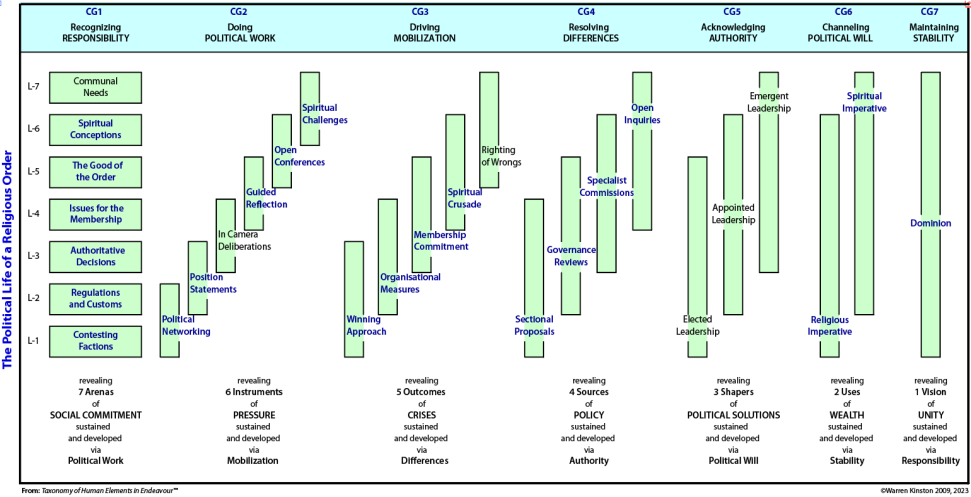Political Activities in a Religious Order
Intense Politics is Normal for a Church
Religious orders represent a form of —more controlled than a fully free society and less structured than an organization.
Joining an order may represent a lifetime commitment. Orders may persist for centuries, far longer than organizations, whose life-span is usually measured in years or decades at most.
Re-naming must capture the spirit of life and work in a religious order. Conjectures offered here are based on a limited understanding from a few meetings and events over the years, as well as some reading.
The new labels offered in the diagram are explained below.
Better viewing: Use browser zoom if needed.

Preliminary Ideas
CG1-Responsible Commitment
, a permanent fixture in organized religions, can be more fittingly described as , and are usually based on different streams or styles of theology and devotion rather than personalities.
contains specific , often detailed and including obedience to .
are similar in principle to what is seen in organizations or society. Perhaps the rule of obedience makes them more .
are essentially dealing with the that preoccupy the , including its leaders.
is now about that members care about and so have as much right to address as do leaders.
become , because this is what primarily grounds and distinguishes any particular order from another order.
does not need to be re-named because the order sees itself as .
CG2-Political Work
perhaps replaces as people seek to affect placement on key committees or determine who is assigned to draft a important document: but perhaps more goes on that outsiders do not get to know about.
probably replaces .
surely remain.
is proposed to replace . It is based on identifying important notions and asking members to consider them thoughtfully and meditatively, and enter a dialogue with a mentor.
replace . These events allow the membership to express, hear and share a variety of views.
replace . Spirituality rather than morality, whether or not followed, is the more profound issue for any order. Morality can be taken for granted, but spirituality is debatable. Spiritual qualities are difficult to assess at the best of times, and slippage under pressure into arrogant or ignorant states is an ever-present danger.
CG3-Mobilization in Crisis
is perhaps more appropriate than .
are replaced by
replaces
Because moral failings in an order reflect spiritual impurities, what might be required in the face of certain types of crisis would be a
remains unchanged.
CG4-Resolving Differences with Policy
Any order will have a governance system with bodies that officially propose, review and sanction However, as in organizations, within the order can put forward their that are naturally built around their factional interests; and within the church but outside the order may be expected to provide an assessment and contribution. involving members of the same or related orders or religions, or people otherwise connected through work, are probably appropriate. Again it would be no surprise to find considerable resistance to conducting such inquiries.
CG5-CG7 Authority for Solutions : Will : Stability
Leadership types remain unchanged in regard to formal names: i.e. they will still be and . However, what these positions entail will surely be significantly different.
The order has emerging from the importance of traditions (however outdated), but also from pressures that are organizational, secular and even profane (e.g. hiding pervasive corruption and the abuse of power).
These can be contrasted to the that should be driving the order towards a better world for themselves and outsiders built on truth, compassion, forgiveness, acceptance and devotion to service.
We have seen in recent years much evidence of how and function in the great religions.
seems inappropriate for an order, and expecting the religion to enable autonomy may not be realistic. However, an order must have genuine over its own affairs so as to manage internal relationships despite factional differences and other external political pressures.
See other applications of this framework:
Originally posted: August-2009; Last updated: 15-Nov-2010, Amended 18-Nov-2023.